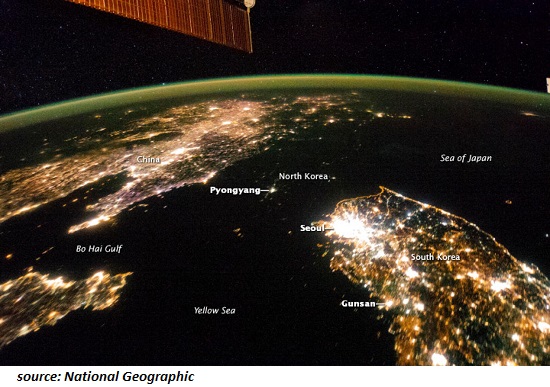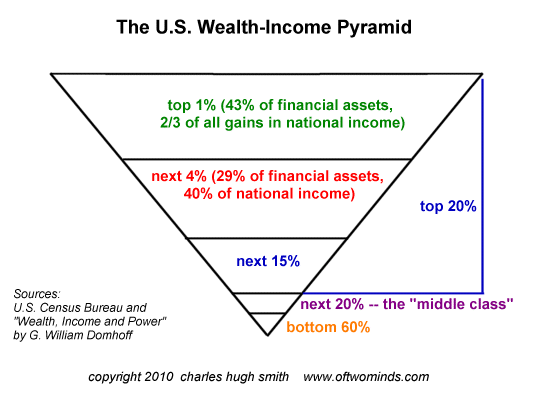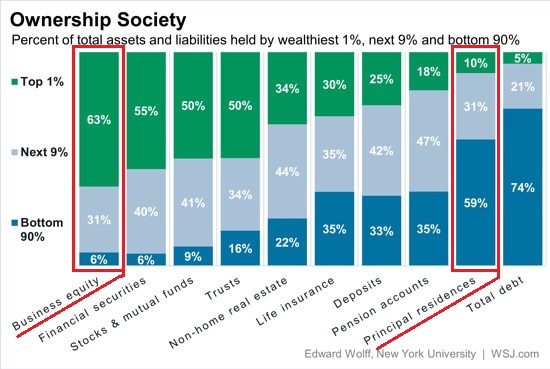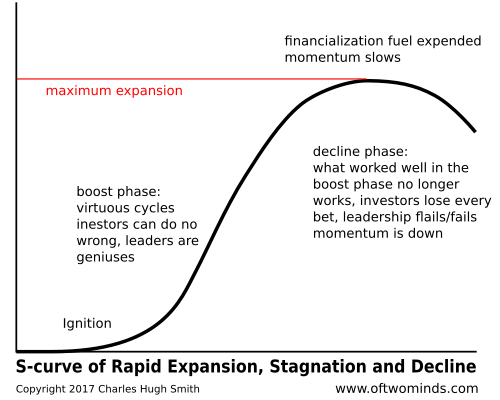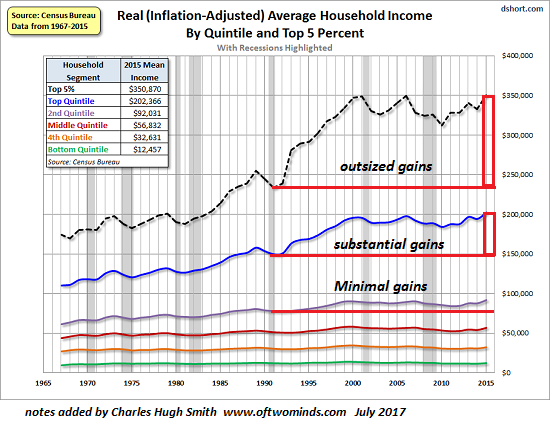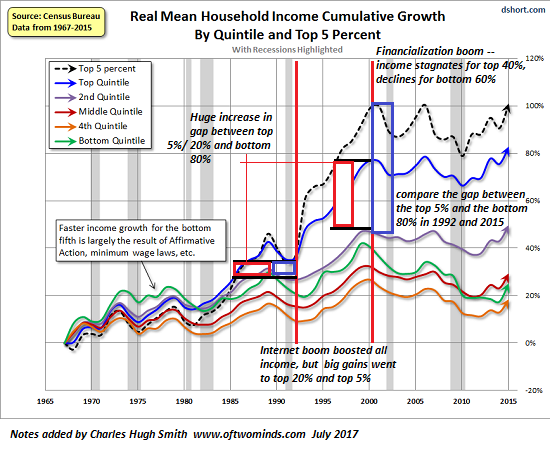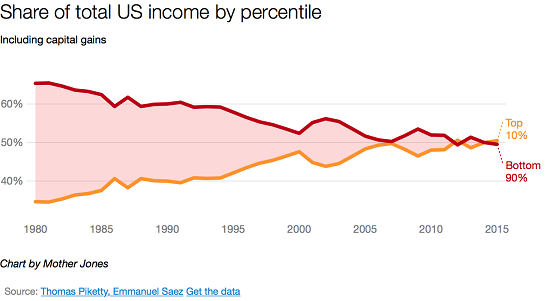The key to broadly distributing opportunity and capital is to nurture the source of social capital: the community economy.
We all know what a hyper-financialized economy looks like--we live in one:central banks create credit/money out of thin air and distribute it to the already-wealthy, who use the nearly free money to buy back corporate shares, enriching themselves while creating zero jobs. Or they use the central-bank money to outbid mere savers to scoop up income-producing assets: farmland, rental properties, etc.
This asymmetric wealth accumulation and avoidance of risk creates a self-reinforcing feedback loop, as the super-wealthy financiers and corporations use a slice of their income to buy political protection of their income streams, creating cartels and quasi-monopolies that are impervious to competition and meaningful regulation.
The only possible output of a hyper-financialized economy is rapidly increasing wealth and income inequality--precisely what we see now.
What we need is a social economy, an economy that recognizes purposes and values beyond maximizing private gains by any means necessary, which is the sole goal of hyper-financialized economies.
Given the dominance of profit-maximizing markets and the state, we naturally assume these are the economy. But there is a third sector, the community economy, which is comprised of everything that isn’t directly controlled by profit-maximizing companies or the state.
What differentiates the community economy from the profit-maximizing market and the state?
1. The community economy allows for priorities and goals other than maximizing profit. Making a profit is necessary to sustain the enterprise, but it is not the sole goal of the enterprise.
2. The community economy is not funded by the state.
3. The community economy is locally owned and operated; it is not controlled by distant corporate hierarchies. The money circulating in the community stays in the community.
4. The community economy is not dominated by moral hazard; the community must live with the consequences of the actions of its residents, organizations and enterprises.
The community economy includes small-scale enterprises, local farmer’s markets, community organizations, social enterprises and faith-based institutions. Its structure is decentralized and self-organizing; it is not a formal hierarchy, though leaders naturally emerge within civic and business groups.
Few Americans have worked on a plantation. I am likely one of the few who has lived and worked in a classic plantation town (Lanai City, circa 1970; I picked pineapples along with my high school classmates as a summer job).
In my analysis, the current financial system is akin to a Plantation Economy:highly centralized and hierarchical, devoted to maximizing profits for distant owners, a finance-fueled machine for extracting wealth from local economies.
I call this the Neocolonial-Financialization Model:
We can differentiate the community economy by comparing it to a hyper-financialized Plantation Economy. In a Plantation Economy, a once-diverse landscape of decentralized, locally owned small enterprises is displaced by corporations that are dependent on the state for their profits via direct subsidies, tax breaks, or a cartel/monopoly enforced by the state. (Think Big Pharma, Big Defense, the Higher Education Cartel, etc.)
The corporate Plantation’s low wages leave many of its workers' families dependent on state aid to survive, and so it prospers on the backs of taxpayers who subsidize its low wages and the externalization of costs.
The current system rewards those with access to cheap capital and the power of the state. The community economy has neither.
The Plantation Economy institutionalizes poverty, parasitic finance, externalized costs, moral hazard (since the corporate/state overseers do not live in the community being cannibalized) and centralized wealth and political power.These are the only possible outputs of the hyper-financialized Plantation Economy.
Once the Plantation Economy has displaced the community economy, opportunities for work and starting small enterprises shrivel, and residents become dependent on state social welfare for their survival. By eliminating the need to be a productive member of the community, the welfare state destroys positive social roles and the inter-connected layers of the community economy between the state and the individual.
When the individual receives social welfare from the state, that individual has no compelling need to contribute to the community or participate in any way other than as a consumer of corporate goods and services. State social welfare guts the community economy by removing financial incentives to participate or contribute.
Why is the community economy so important? The community economy is first and foremost the engine of social capital, which is the source of opportunity and widely distributed wealth.
Social capital is the sum of all the connections and relationships that enable productive collaboration, commerce, exchange and cooperation. (I cover all eight kinds of capital in my book.)
Corporations offer a limited version of social capital--for example, meeting a manager in another department at a company picnic--but most of this capital vanishes once an individual leaves the company (or is "right-sized" into unemployment). This social capital is only superficially embedded in a place and community, as corporations routinely move operations in pursuit of their core purpose: expanding profits.
Corporations cannot replace communities for the simple reason each organization has different purposes and goals. The sole purpose and goal of a corporation is to expand capital and profits, for if it fails to do so, it falters and expires.
The purpose of a community is to preserve and protect a specific locale by nurturing social solidarity: the sense of sharing a purpose with others, of belonging to a community that is capable of concerted, collective action on the behalf of its members and its locale.
Political scientist Robert Putnam has described this structure as a web of horizontal social networks. Unlike corporations and the state, community economies are horizontal networks, i.e. networks of peers connected by overlapping memberships and interests.
It is not accidental that the current system of hierarchical corporations, banks and the state increases inequality and erodes the community economy: the only possible output of low social capital is rising inequality.
Putnam identified a correlation between the inequalities enforced by oppressive elites (slavery being the most extreme example) fearful of the potential of egalitarian (horizontal) networks to organize resistance to their exploitation.
Areas with low social capital are characterized by limited social mobility and rising economic inequality. In other words, the only way to lessen economic inequality is to nurture the horizontal peer-to-peer community economy that creates social capital.
This makes sense, as communities stripped of social capital offer limited access to the other forms of capital needed to launch local enterprises and construct ladders of social mobility.
A vibrant community economy provides members with an infrastructure of opportunity, i.e. multiple pathways to building capital, gaining knowledge and connecting with others.
The key to broadly distributing capital and reversing inequality is to nurture the source of social capital: the community economy.
"Certainly the author is decades ahead of his time. Humanity will eventually adopt the author's principles written in all of his books. Currently, humanity lives in delusion that the system will continue to serve them. We will see massive changes even in the next decade. Don't waste your money on college--buy the author's books and succeed." Book Reader (via Amazon.com)
If you found value in this content, please join me in seeking solutions by becoming a $1/month patron of my work via patreon.com.
NOTE: Contributions/subscriptions are acknowledged in the order received. Your name and email remain confidential and will not be given to any other individual, company or agency.
>
Thank you, Caitlin R. ($5/month), for your splendidly generous pledge to this site -- I am greatly honored by your support and readership.
| |
Thank you, Jonathan M. ($5/month), for your superbly generous pledge to this site -- I am greatly honored by your support and readership.
|
Read more...
